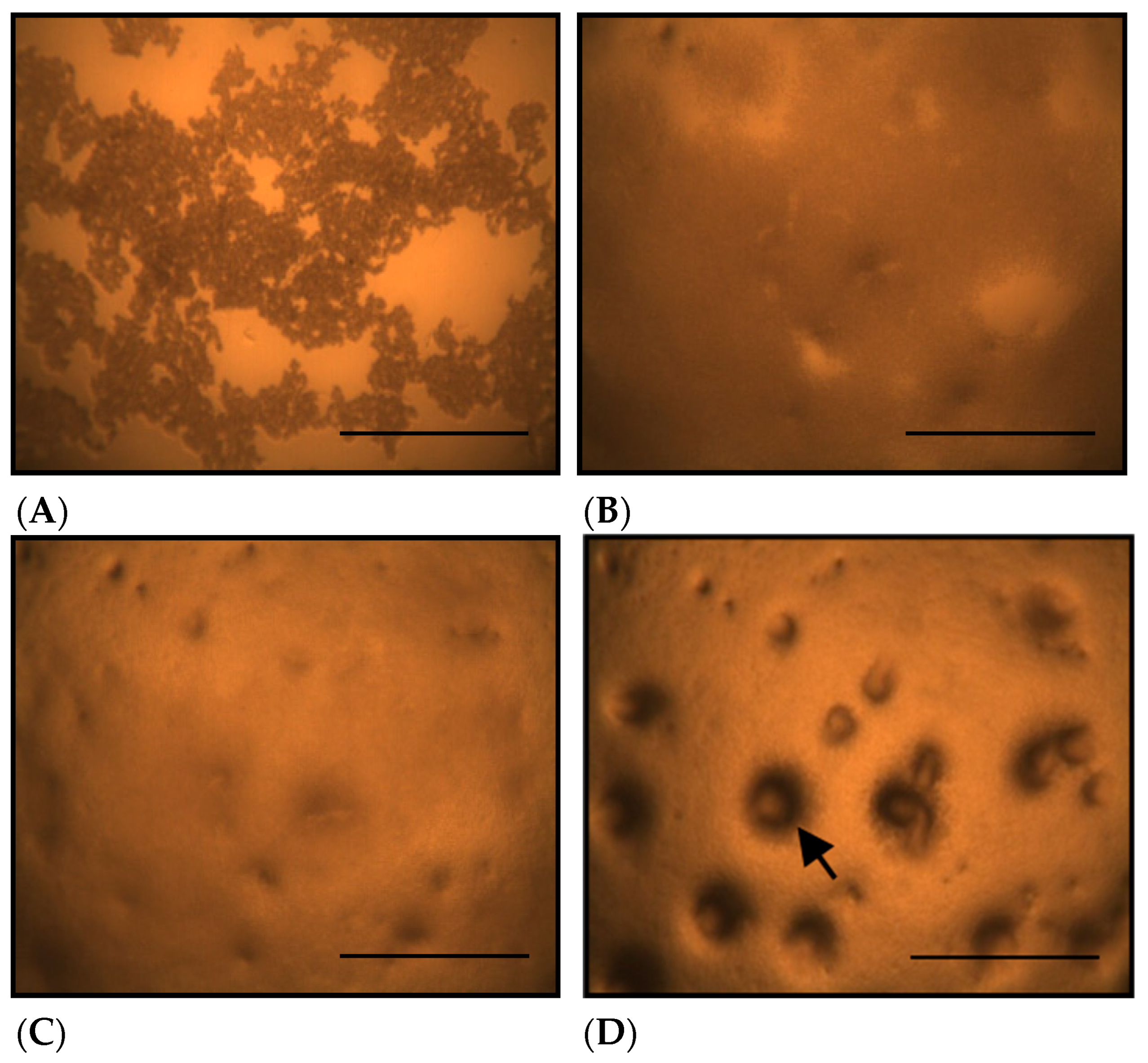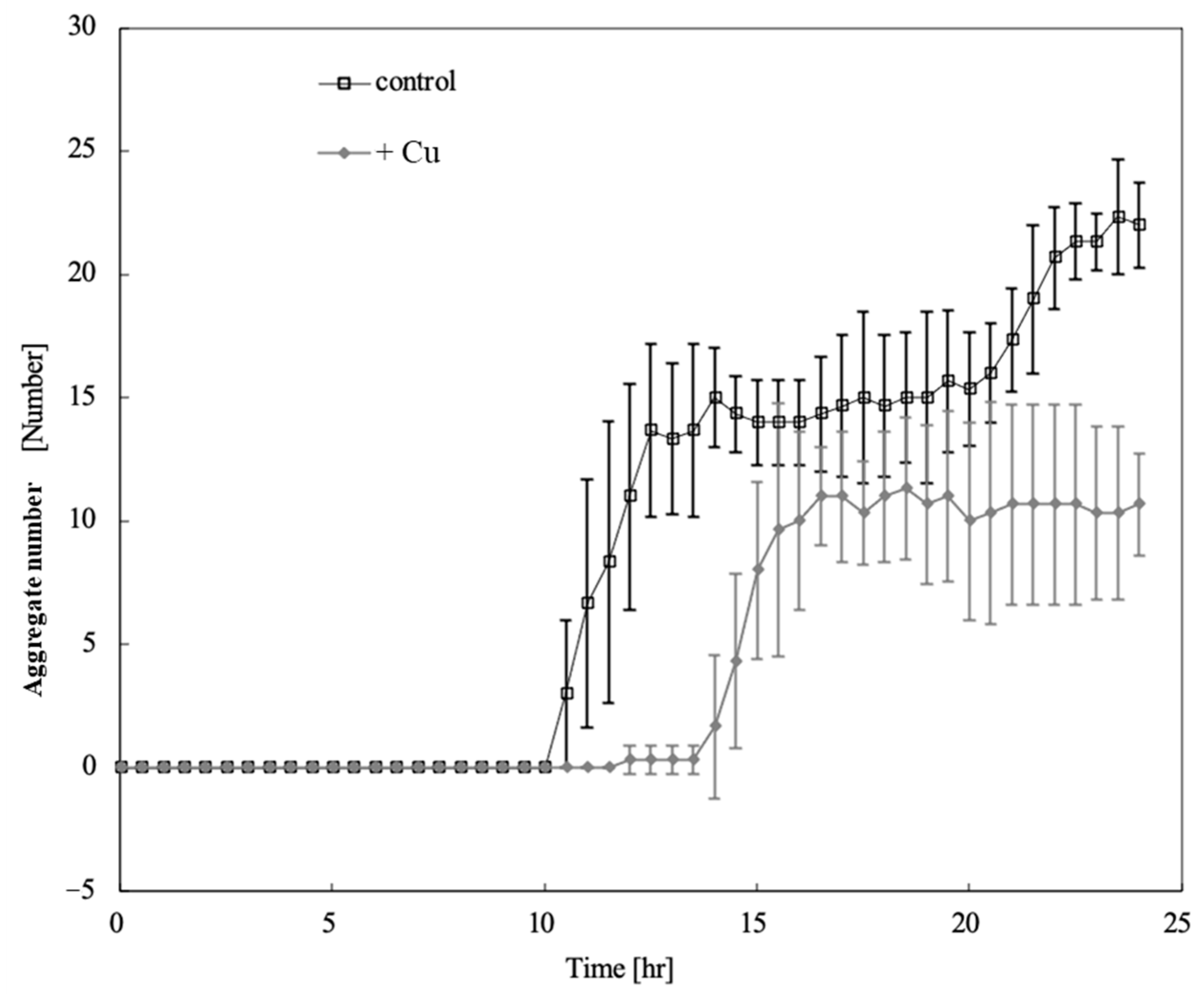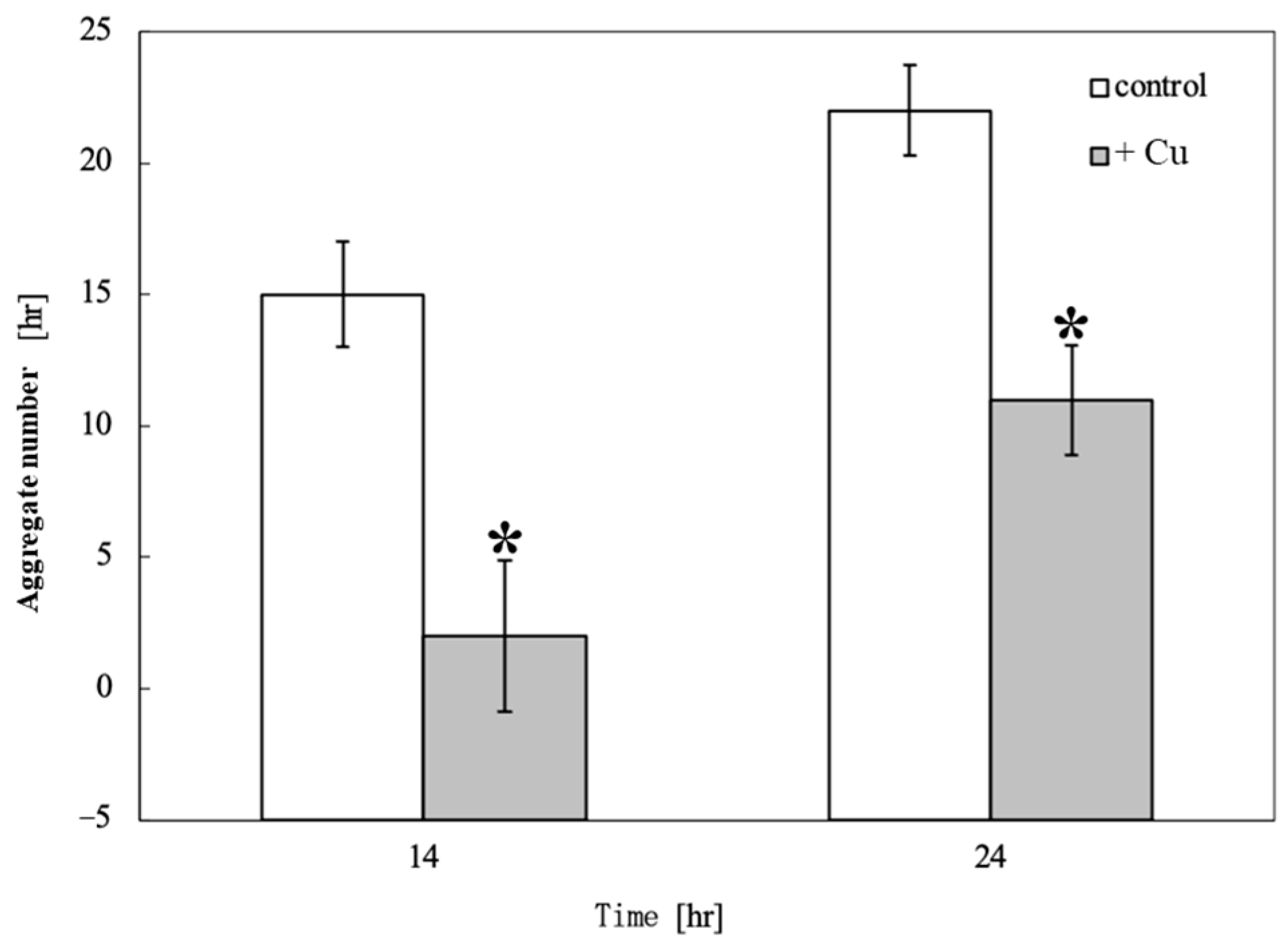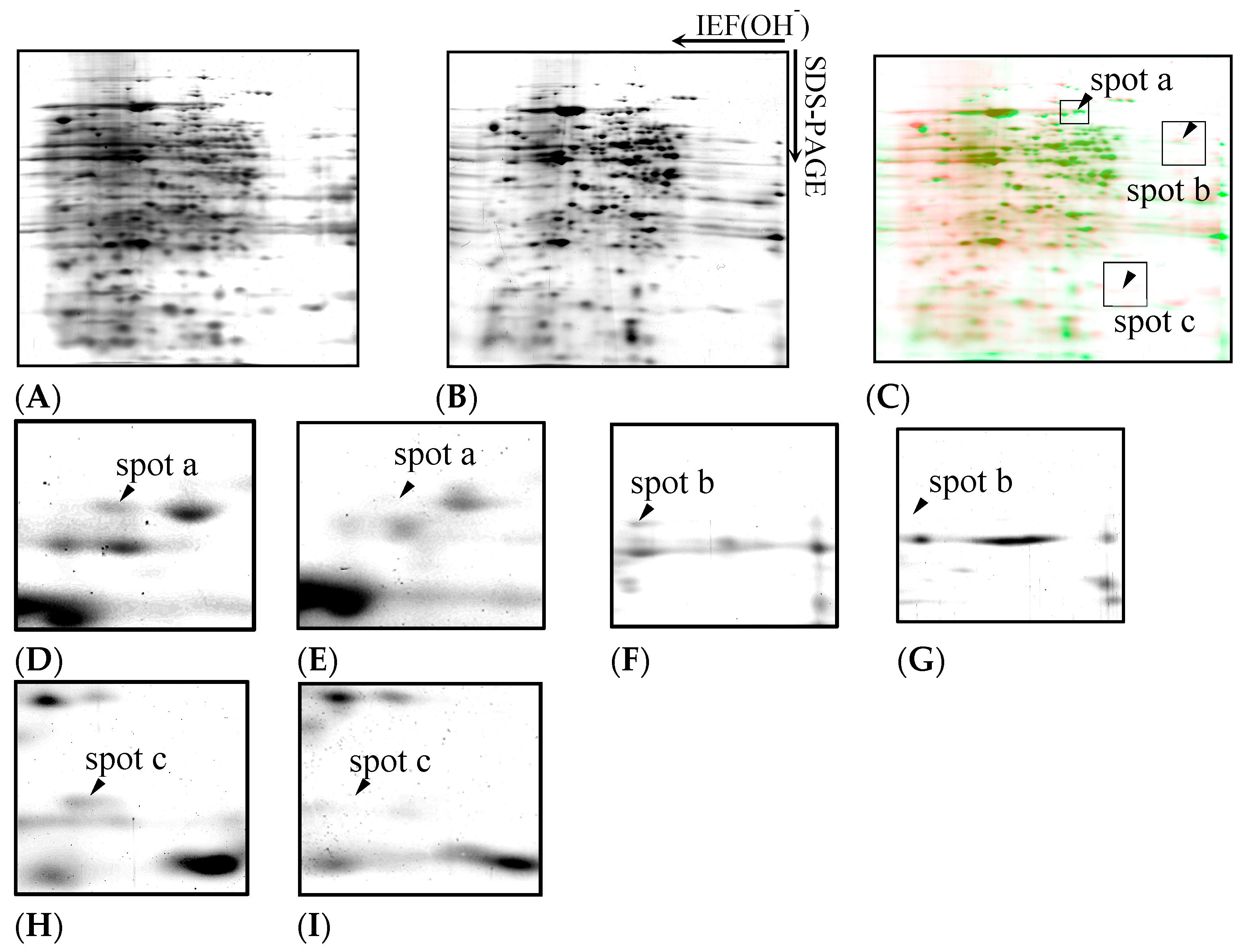Proteomic Analysis of Heavy Metal-Induced Toxicity Using the Cellular Slime Mould Dictyostelium discoideum: Effects of Copper Exposure on Aggregation and Protein Expression
Abstract
1. Introduction
2. Materials and Methods
2.1. Chemicals
2.2. Strain and Culture Conditions
2.3. Aggregation Assay
2.4. Protein Extraction and Quantification
2.5. Two-Dimensional Gel Electrophoresis (2-DE)
2.6. Image and Data Analysis
3. Results
3.1. Morphological Observations
3.2. Proteomic Analysis
4. Discussion
5. Conclusions
Author Contributions
Funding
Institutional Review Board Statement
Informed Consent Statement
Data Availability Statement
Conflicts of Interest
Abbreviations
| SDS-PAGE | Sodium Dodecyl Sulphate Polyacrylamide Gel Electrophoresis |
References
- Focazio, M.J.; Kolpin, D.W.; Barnes, K.K.; Furlong, E.T.; Meyer, M.T.; Zaugg, S.D.; Barber, L.B.; Thurman, M.E. A national reconnaissance for pharmaceuticals and other organic wastewater contaminants in the United States—II) Untreated drinking water sources. Sci. Total Environ. 2008, 402, 201–216. [Google Scholar] [CrossRef]
- Kolpin, D.W.; Furlong, E.T.; Meyer, M.T.; Thurman, E.M.; Zaugg, S.D.; Barber, L.B.; Buxton, H.T. Pharmaceuticals, hormones, and other organic wastewater contaminants in U.S. streams, 1999–2000: A national reconnaissance. Environ. Sci. Technol. 2002, 36, 1202–1211. [Google Scholar] [CrossRef]
- Adak, T.; Govindharaj, G.; Panneerselvam, P.; Gadratagi, B.G.; Kumar, U. Imidacloprid application changes microbial dynamics and enzyme activities in tropical rice soil. Ecotoxicol. Environ. Saf. 2017, 144, 123–130. [Google Scholar] [CrossRef]
- Wang, X.; Chai, J.; Liu, W.; Zhu, X.; Liu, H.; Wei, X. Biochar, soil and land-use interactions that reduce nitrate leaching and nitrous oxide emissions: A meta-analysis. Sci. Total Environ. 2018, 651, 2354–2364. [Google Scholar] [CrossRef]
- Hajam, A.H.; Ali, M.S.; Singh, S.K.; Bashri, G. Understanding cytokinin: Biosynthesis, signal transduction, growth regulation, and phytohormonal crosstalk under heavy metal stress. Environ. Exp. Bot. 2024, 228, 106025. [Google Scholar] [CrossRef]
- Liu, Y.; Wang, Y.; Zhang, H. Waterborne polyurethane composites with antibacterial activity by incorporating p-BzOH intercalated MgAl-LDH. Compos. Commun. 2019, 13, 112–118. [Google Scholar] [CrossRef]
- Gaetke, L.M.; Chow, C.K. Copper toxicity, oxidative stress, and antioxidant nutrients. Toxicology 2003, 189, 147–163. [Google Scholar] [CrossRef]
- Francesco, D.; Henrik, J.; Mauro, R.; Gabriella, P.; Elena, B.; Giovanni, P.; Aldo, V. Cellular responses to environmental contaminants in amoebic cells of the slime mould Dictyostelium discoideum. Biochem. Physiol. C Toxico. Pharmacol. 2005, 143, 150–157. [Google Scholar] [CrossRef]
- Francesco, M.; Lara, B.; Elia, R.; Maria, C.; Valeria, M.; Francesco, D.; Aldo, V. Effects of mercury on Dictyostelium discoideum: Proteomics reveals the molecular mechanisms of physiological adaptation and toxicity. J. Proteome Res. 2010, 9, 2839–2854. [Google Scholar] [CrossRef]
- Sforzini, S.; Dagnino, A.; Torrielli, S.; Dondero, F.; Fenoglio, S.; Negri, A.; Boatti, L.; Viarengo, A. Use of highly sensitive sublethal stress responses in the social amoeba Dictyostelium discoideum for an assessment of freshwater quality. Sci. Total. Environ. 2008, 395, 101–108. [Google Scholar] [CrossRef]
- Laemmli, U.K. Cleavage of structural proteins during assembly of the head of bacteriophage T4. Nature 1970, 227, 680–685. [Google Scholar] [CrossRef] [PubMed]
- Ali, H.; Khan, E.; Sajad, M.A. Phytoremediation of heavy metals—Concepts and applications. Chemosphere 2013, 91, 869–881. [Google Scholar] [CrossRef] [PubMed]
- Leung, M.C.; Williams, P.L.; Benedetto, A.; Au, C.; Helmcke, K.J.; Aschner, M.; Meyer, J.N. Caenorhabditis elegans: An emerging model in biomedical and environmental toxicology. Toxicol. Sci. 2008, 106, 5–28. [Google Scholar] [CrossRef] [PubMed]
- Faix, J.; Grosse, R. Staying in shape with formins. Dev. Cell 2006, 10, 693–706. [Google Scholar] [CrossRef]
- Junemann, A.; Winterhoff, M.; Nordholz, B.; Rottner, K.; Eichinger, L.; Gräf, R.; Faix, J. ForC lacks canonical formin activity but bundles actin filaments and is required for multicellular development of Dictyostelium cells. Euro. J. Cell Biol. 2013, 92, 201–212. [Google Scholar] [CrossRef]
- Lakha, R.; Hachicho, C.; Mehlenbacher, M.R.; Wilcox, D.E.; Austin, R.N.; Vizcarra, C.L. Metallothionein-3 attenuates the effect of Cu2+ ions on actin filaments. J. Inorg. Biochem. 2023, 242, 112157. [Google Scholar] [CrossRef]
- Insall, R.H.; Borleis, J.; Devreotes, P.N. The aimless RasGEF is required for processing of chemotactic signals through G-protein-coupled receptors in Dictyostelium. Curr. Biol. 1996, 6, 719–729. [Google Scholar] [CrossRef]
- Fabbri, E.; Capuzzo, A. Adenylyl cyclase activity and its modulation in the gills of Mytilus galloprovincialis exposed to Cr6+ and Cu2+. Aquat. Toxicol. 2006, 76, 59–68. [Google Scholar] [CrossRef]
- D’Andrea, L.D.; Regan, L. TPR proteins: The versatile helix. Trends Biochem. Sci. 2003, 28, 655–662. [Google Scholar] [CrossRef]
- Bouron, A.; Kiselyov, K.; Oberwinkler, J. Permeation, regulation and control of expression of TRP channels by trace metal ions. Pflügers Arch. Eur. J. Physiol. 2015, 467, 1146–1164. [Google Scholar] [CrossRef]
- Williams, R.S.; Boeckeler, K.; Graf, R.; Muller-Taubenberger, A.; Li, Z.; Ismailoglu, I.; Gourley, C. Dictyostelium discoideum as a model for the study of neurodegenerative diseases. Semin. Cell Dev. Biol. 2006, 17, 512–524. [Google Scholar] [CrossRef]
- Zhu, J.; Fu, X.; Lin, H.; Chen, L.; Jin, Y. Proteomic analysis of copper stress response in rice seedlings. Environ. Sci. Pollut. Res. 2019, 26, 20524–20533. [Google Scholar] [CrossRef]





| Spot | Experiment Value | Protein Name | DictybaseID | ExPasy Data Base | |||
|---|---|---|---|---|---|---|---|
| pI | Mw (kDa) | DDB | pI | Mw (Da) | Rank | ||
| a | 6.3 | 102 | formin-1 | DDB_G0284519 | 6.27 | 106,462 | 1 |
| probable ATP-dependent RNA helicase ddx10 | DDB_G0284017 | 6.24 | 100,359 | 2 | |||
| mental retardation GTPase activating protein homolog 2 | DDB_G0270024 | 6.33 | 97,411 | 3 | |||
| dynamin-like protein A | DDB_G0268592 | 6.4 | 101,404 | 4 | |||
| folliculin interacting protein repeat-containing protein | DDB_G0271996 | 6.29 | 105,881 | 5 | |||
| myb-like protein K | DDB_G0276877 | 6.32 | 100,912 | 6 | |||
| b | 8.1 | 78 | cytoplasmic regulator of adenylylcyclase | DDB_G0285161 | 8.08 | 78,499 | 1 |
| target of Myb protein 1 | DDB_G0290163 | 8.1 | 75,375 | 2 | |||
| inner no outer 80 complex subunit D | DDB_G0288447 | 8.07 | 78,233 | 3 | |||
| cycloartenol synthase | DDB_G0269226 | 8.19 | 80,763 | 4 | |||
| c | 7.5 | 31 | tetratricopeptide repeat-containing protein | DDB_G0285095 | 7.57 | 29,748 | 1 |
Disclaimer/Publisher’s Note: The statements, opinions and data contained in all publications are solely those of the individual author(s) and contributor(s) and not of MDPI and/or the editor(s). MDPI and/or the editor(s) disclaim responsibility for any injury to people or property resulting from any ideas, methods, instructions or products referred to in the content. |
© 2025 by the authors. Licensee MDPI, Basel, Switzerland. This article is an open access article distributed under the terms and conditions of the Creative Commons Attribution (CC BY) license (https://creativecommons.org/licenses/by/4.0/).
Share and Cite
Itoh, A.; Kurihara, K.; Shoji, R. Proteomic Analysis of Heavy Metal-Induced Toxicity Using the Cellular Slime Mould Dictyostelium discoideum: Effects of Copper Exposure on Aggregation and Protein Expression. Toxics 2025, 13, 665. https://doi.org/10.3390/toxics13080665
Itoh A, Kurihara K, Shoji R. Proteomic Analysis of Heavy Metal-Induced Toxicity Using the Cellular Slime Mould Dictyostelium discoideum: Effects of Copper Exposure on Aggregation and Protein Expression. Toxics. 2025; 13(8):665. https://doi.org/10.3390/toxics13080665
Chicago/Turabian StyleItoh, Atsuko, Koji Kurihara, and Ryo Shoji. 2025. "Proteomic Analysis of Heavy Metal-Induced Toxicity Using the Cellular Slime Mould Dictyostelium discoideum: Effects of Copper Exposure on Aggregation and Protein Expression" Toxics 13, no. 8: 665. https://doi.org/10.3390/toxics13080665
APA StyleItoh, A., Kurihara, K., & Shoji, R. (2025). Proteomic Analysis of Heavy Metal-Induced Toxicity Using the Cellular Slime Mould Dictyostelium discoideum: Effects of Copper Exposure on Aggregation and Protein Expression. Toxics, 13(8), 665. https://doi.org/10.3390/toxics13080665







